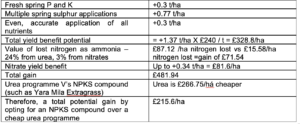Farmers are rightly thinking long and hard about which fertiliser to buy for spring application.
We all know how important nitrogen (N) is to crop growth, however it can be easy to overlook the need for sulphur (S), phosphorus (P) and potassium (K) too. But without all four nutrients the crop will not grow effectively, impacting yields and ultimately profit margins.
We know that levels of both N and S in the soil are limited and therefore the deficit in requirement needs to come from manures or mineral fertilisers. With P and K we rely on soil indices to tell us how much to apply, but even on index 2 or more, fresh applications give a better use efficiency due to availability in the soil at the time crops require the nutrients.
“This points towards an NPKS approach being a good option for Cereals this coming spring”, comments Mark Tucker, Head of Agronomy for Yara UK, “avoiding multiple single-element passes, as well as delivering an even spread”.
Still farmers will be looking at the cost of Urea as a straight N delivery compared to an NPKS compound.
“On the face of it, Urea is always going to be cheaper than an NPKS compound”, says Mark Tucker. “However, we’ve looked at the detail and farmers will be surprised that an NPKS compound is actually more cost effective than urea/straight AN products”.
The table below shows the key points to note:
In addition, if a straight N program approach is taken then farmers will also have to think of applying P, K and S separately into the programme, this means they will have 3 extra passes and 6 in total. Given the price of fuel at the moment, this soon adds up to a significant amount, approximately £15/ha each pass.
“Therefore, for a simple and cost-effective approach to nutrition for 2023, a product such as YaraMila Extragrass (27-5-5+ 6% SO3) is a really good option and one I would ask farmers to seriously consider,” concludes Mr Tucker.




